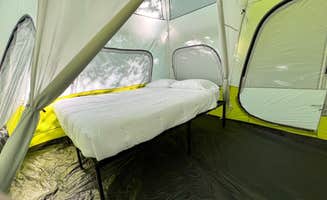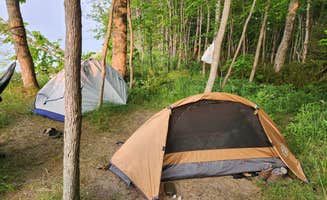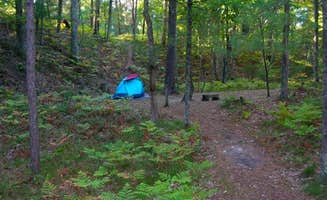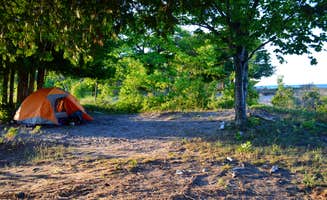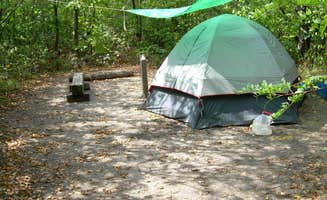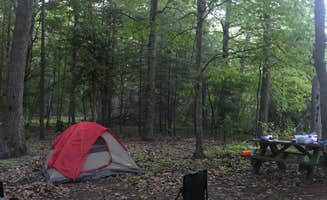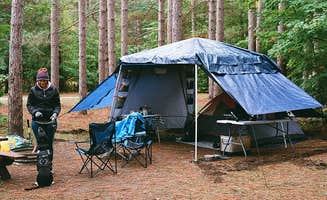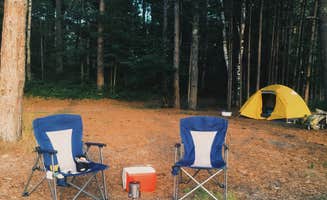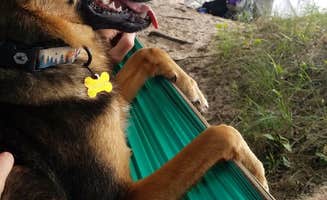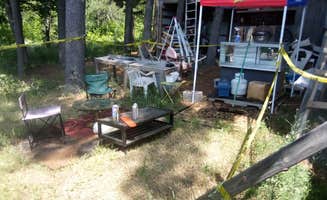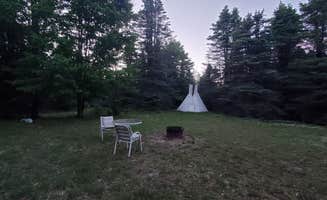Tent campsites near Glen Arbor, Michigan primarily occupy island territories where dense forests meet freshwater shorelines. Most campsites sit at elevations between 580-700 feet above sea level, offering moderate temperature variations between day and night. Summer temperatures typically range from 55-80°F with humidity levels averaging 65-75%, while rainfall occurs approximately 12 days per month during peak season.
What to do
Hike to historic sites: On South Manitou Island, trails lead to abandoned farms and historic structures. "Hiking trails on the island are well marked, and fairly easy. I would recommend staying 2 nights if you want to see the whole island, though," reports Amy S. from South Manitou Island Group.
Explore underwater attractions: The shipwreck of the Corazon is accessible from South Manitou Island. "You can hike to see the wreck of the Corazon, the cedar forest or the old homestead farms. We ate sweet plums that were ripe from one of the old trees on one of the farms," notes Annette B.
Climb sand dunes: Multiple hiking trails cross the dunes connecting campsites to beaches. "Once we got to the western shore, we hiked another mile or so to Donner Point, where we found excellent ground for our tents and it was completely isolated. Gorgeous views," shares Jason H. from North Manitou Island Backcountry Campsites.
Fish for smallmouth bass: Lake Manitou on North Manitou Island offers productive fishing spots. "If you pack your fishing pole to lake manitou, located in the center of the lake, you can experience amazing small mouth bass fishing," recommends Dalton B.
What campers like
Privacy between sites: Many campsites feature good spacing and natural barriers. "The nice thing about a smaller campground and less sites is that they were separated really well. There was quite a bit of space between the sites, so it didn't feel like you were right on top of each other," notes Ashley W. about Popple Campground.
Watching weather patterns: Elevated campsites provide views of storms moving across the lake. "I even got to watch a small rainstorm roll in across the lake, and hurry up the dune to my tent when it got close," shares Michael G.
Community fire rings: Some island campsites offer communal fire areas. "There are community fire rings which led to a fun final night on the island passing some of my flasks around with fellow hikers," describes Jason H. from Village Campground.
Easy access for first-time backpackers: The relatively short distances and simple terrain make this area suitable for beginners. "THIS PLACE IS AWESOME! Taking a ferry is definitely an experience but then they drop you off in an old abandon village. From there you take off in any direction and find a cool place to camp," explains Steve D.
What you should know
No-fire zones: Fire restrictions vary by location. "Fires are only permitted in the Village Campsite at the island's entrance & you cannot camp within 300 ft of the beach," cautions Anna C.
Water filtration required: Most sites lack potable water sources. "Bring your own water, filter from the lake and purify, or get it from the pump near the dock on Power Island," advises GoWhereYouAreDraw N. about Power Island County Park Primitive Campsites.
Ferry reliability concerns: Weather affects transportation schedules. "The ferry is unable to reach the island in dangerous weather conditions," warns Kristy C. from Weather Station Campground.
Insect preparation: Summer months bring mosquitoes to wooded areas. "Mid July was very buggy," notes Jason H., while Tammy G. advises "bring deet" for South Manitou Island camping.
Tips for camping with families
Pack extra supplies: Children may consume more food than anticipated. "I'd also recommend bringing more food than you think you need, in case the weather turns and the ferry can't pick you up on the day planned," suggests Amy S.
Consider shorter stays for young children: The isolation and primitive conditions can be challenging for extended stays with small children. "My four year old son and I took the ferry to South Manitou Island and had planned to stay for a few days. We had numerous people gift us food they had packed over to the island and did not want to pack out," reports Annette B.
Start with shorter trails: Several easy hiking options exist for families. "The campground offers a shared fire pit, log benches to sit on, and access to a pit toilet," notes Kristy C. about Weather Station Campground's amenities that make family camping easier.
Stay near village areas: Campsites closer to dock facilities provide easier access to resources. "This designated campground on North Manitou is a short walk from the village where you have access to potable water as well as vault toilets," states Jason H.
Tips from RVers
Consider land-based alternatives: Since island camping requires boat transportation, RV travelers should look to mainland options. "White Pine Backcountry Camp is just 1.5 miles on a very easy sandy trail from the parking area at the Lake Michigan shore," notes Shari G. about White Pine Backcountry Camp.
Use RVs as base camps: Park RVs at mainland campgrounds and use them as staging areas for day trips to islands. "Starting off with the ferry ride that leaves from Leland, MI was a pleasure created with smiling faces from the crew," describes Michelle S., suggesting day-trip options.
Pack efficiently for island excursions: When transitioning from RV to island camping, minimize gear. "Your choice is yours, stay in one of the near by camps close to the ferry dock or explore several miles around the island," explains Michelle S.


